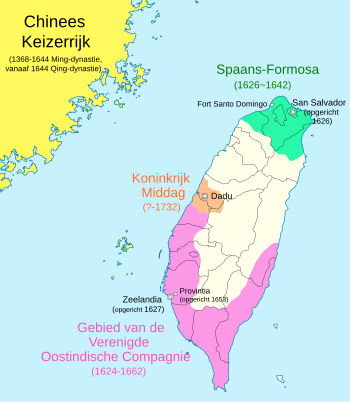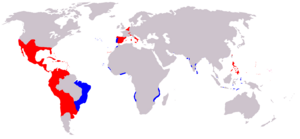Spanish Formosa facts for kids
Quick facts for kids
Spanish Formosa
|
|||||||||
|---|---|---|---|---|---|---|---|---|---|
| 1626–1642 | |||||||||
|
Flag of New Spain
|
|||||||||

The locations of Spanish Formosa, overlapping a map of the present-day island. Spanish Possessions Dutch possessions Kingdom of Middag
|
|||||||||
| Status | Colony of Spain (Territory of the Spanish East Indies from 1626 to 1642) |
||||||||
| Capital | San Salvador (Keelung) | ||||||||
| Common languages | Spanish (official) East Formosan languages |
||||||||
| Religion | Roman Catholicism | ||||||||
| Government | Colony | ||||||||
| Historical era | Age of Discovery | ||||||||
|
• Established
|
1626 | ||||||||
|
• Surrender of San Salvador
|
1642 | ||||||||
| Currency | Spanish real | ||||||||
|
|||||||||
| Today part of | Republic of China (Taiwan) | ||||||||
Spanish Formosa (Spanish: Gobernación de Formosa española) was a small colony of the Spanish Empire. It was located on the northern part of an island that Europeans called Formosa (now Taiwan).
The Spanish controlled this area from 1626 to 1642. They lost it to the Dutch Republic during a long conflict known as the Eighty Years' War.
The Portuguese were the first Europeans to see the island in 1544. They named it Formosa, which means "beautiful" in Portuguese. They thought the island looked very beautiful from the sea.
Northern Taiwan became a Spanish colony in 1626. It was part of the Spanish East Indies, which was managed from Manila in the Philippines. The Spanish wanted this colony to protect their trade routes. They especially wanted to keep the Dutch from bothering their ships.
The Dutch had a base in the south of Formosa. The Spanish colony did not last long. Spain decided it was not important enough to send more soldiers and supplies. After 17 years, Dutch forces attacked the last Spanish fort. The Spanish lost control, and the Dutch took over most of the island.
During the time of Spanish rule, missionaries taught about Christianity. About 5,000 Taiwanese people became Christians.
Contents
Why Spain Came to Formosa
In 1566, the Dutch people rebelled against King Philip II of Spain. This started a long war called the Eighty Years' War. The Dutch Republic, along with England and France, attacked some of Spain's lands far away.
Spain stopped the Dutch from buying spices in Lisbon, Portugal. This made the Dutch send their own ships to Asia to find spices. They wanted to control the valuable spice trade in the East Indies.
Portugal and Spain joined together in 1580. This meant the Dutch had to fight both Portugal and Spain. England and France also became enemies of both countries.
The Dutch wanted to take over Spanish lands in Asia, including the Philippines. They attacked Spanish forts that were often not well-guarded. These forts were sometimes far away and hard to help if attacked. But the Dutch did not often succeed in taking them.
The Dutch wanted new ways to trade with Asia. In 1600, a Dutch pirate named Olivier van Noort reached the Philippines. The Dutch wanted to control sea trade in Southeast Asia. They often acted like pirates, attacking ships and bothering the coasts around Manila Bay. They especially targeted Chinese and Japanese trading ships.
Because of this competition, the Dutch set up a colony in southern Formosa. It was in a place called Tayouan, which is now Anping. From there, they tried to stop Spain's trade. To fight back, the Spanish leaders in Manila decided to build their own colony in northern Formosa.
How the Colony Was Run
Spanish Formosa was a "governorate." This means it was led by a governor. The governor reported to the main leader in Manila, called the "captain general." The captain general then reported to the "viceroy" in Mexico City. The viceroy was chosen by the King of Spain.
Here are the governors of Spanish Formosa:
- Antonio Carreño Valdés (1626–1629)
- Juan de Alcarazo (1629–1632)
- Bartolomé Díaz Barrera (1632–1634)
- Alonso García Romero (1634–1635)
- Francisco Hernández (1635–1637)
- Pedro Palomino (1637–1639)
- Cristóbal Márquez (1639–1640)
- Gonzalo Portillo (1640–1642)
The First Years (1626–1629)

The Spanish landed at Cape Santiago in northeast Formosa. But they found it was not a good place to build defenses. So, they sailed west along the coast until they reached Keelung.
Keelung had a deep, safe harbor and a small island at its entrance. This made it a perfect spot for their first settlement. They named it Santissima Trinidad. They built forts on the island and in the harbor itself.
In 1629, the Spanish built a second base. It was centered around Fort San Domingo in Tamsui.
First Battle with the Dutch
In 1641, the Spanish colony in the north was bothering the Dutch in the south. So, the Dutch decided to take northern Formosa by force. But this first attempt failed.
The Dutch governor, Paulus Traudenius, sent a polite letter to the Spanish governor. He told him about their plans.
Sir,
I have the honor to tell you that I have been given command of many ships and soldiers. My goal is to take control of the fortress Santissima Trinidad in Ke-lung, which you govern. I will do this peacefully or by force.
It is the custom of Christian nations to announce their plans before fighting. So, I now ask you to surrender. If you agree to our terms and hand over the fortress of Santissima Trinidad and other forts, you and your soldiers will be treated fairly, as is the custom in war. But if you ignore this request, we will have no choice but to fight. I hope you will think carefully about this letter and avoid needless bloodshed. Please let me know your decision quickly.
May God protect you for many years,
Your Friend,
PAULUS TRAUDENIUS
The Spanish governor did not want to give up easily. He sent a strong reply.
Sir; I received your letter of August 26. I must tell you that, as a good Christian who remembers his promise to his king, I cannot and will not surrender the forts you demand. My soldiers and I are determined to defend them. I am used to facing large armies and have fought many battles in Flanders and other places. So, please do not bother writing me more letters like this. Let each of us defend ourselves as best we can. We are Spanish Christians, and God, in whom we trust, is our protector.
May the Lord have mercy on you.
Written in our main fortress San Salvador on September 6, 1641.
GONSALO PORTILIS
After this, the Dutch attacked the Spanish areas in the north. But the Spanish defenses were strong. The Dutch soldiers could not break through the fort walls. They had to go back to their base at Fort Zeelandia, defeated and embarrassed.
Second Battle with the Dutch
In 1642, the Spanish governor in Manila called back most of his soldiers from Formosa. He needed them for a trip in the Philippines. In August of that year, the Dutch saw their chance. The Spanish forces were weaker.
The Dutch returned to Keelung with four large ships, several smaller ones, and about 369 Dutch soldiers. A small group of Spaniards, Formosan natives, and Kapampangan people from the Philippines tried to fight off the larger Dutch force.
After six days of fighting, the small Spanish force surrendered the fort. They were sent back to Manila defeated. They had to give up their flags and the few cannons they had left.
Sebastián Hurtado de Corcuera, who was the governor of the Philippines, was blamed for losing Formosa. He was even put on trial and sent to prison in the Philippines for five years. Historians have often criticized him for this loss. However, other reasons also played a part, like the small number of soldiers and supplies available to defend such a far-off place.
See also
 In Spanish: Gobernación de Formosa española para niños
In Spanish: Gobernación de Formosa española para niños
- Dutch Formosa
- Kingdom of Middag
- Kingdom of Tungning
- Spanish expedition to Formosa



